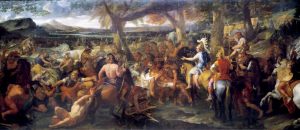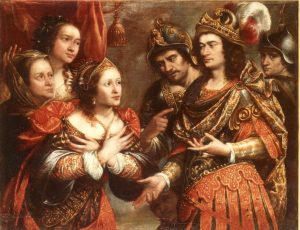
Hephaestion was a general in Alexander the Great’s army and was the closest friend of the famous conqueror. He was born around 356 B.C., in Pella, to a general in Philip II’s army. Hephaestion was believed to be the same age as Alexander.
Beginnings of the Friendship
Alexander and Hephaestion grew up together and became good friends. When the time came that Alexander had to be removed from his maternal uncle’s care and given over to the philosopher Aristotle for his education, Hephaestion came along with him. For three years, the two boys, along with other sons of prominent people, studied logic, morals, religion, art, and philosophy. These three years of studying had impressed themselves on the mind of the young Macedonian, and later, he would designate his childhood friends as his officers in his army’s elite cavalry, called the Companions. Of all his officers, though, he chose Hephaestion as the leader.
In 340 B.C, when Alexander was just sixteen years old, his father, Philip II, had to march his troops to fight in Byzantium. Philip called for his son to head home to Pella and serve as regent. Alexander thus had to stop his education under Aristotle and head home. Philip’s absence emboldened the nearby Maedi tribe to rise up in revolt, and Alexander’s leadership and combat skills were tested. This test turned out to be an early indication of Alexander’s capability as a commander, as he easily defeated the rebels and chased them off from their homeland. He ordered a new city built on the defeated tribe’s land and named it Alexandroupolis.
Hephaestion’s Presence in Alexander’s Campaigns
When Alexander set foot in the city of Troy, he paid homage to the tomb of his cherished childhood hero, Achilles. Aristotle had taught him well about Homer’s Iliad, and so now, Alexander placed a wreath on Achilles’ tomb. Meanwhile, Hephaestion placed a wreath on top of Patroclus’ tomb. After this, the two ran a race while naked as a form of worship for their heroes. In Homer’s epic poem, the relationship between Patroclus and Achilles is non-sexual, but in later times, such as that of Alexander, the relationship was taken to be sexual. Alexander and Hephaestion’s act of placing wreaths on the two heroes could have been their way of flaunting to the public their romantic relationship.
When Alexander crushed the army of King Darius III of Persia, the Persian king fled, leaving not only his harem behind but also his mother, Sisygambis. Sisygambis then acknowledged the conquerors by bowing before Hephaestion, thinking that he was Alexander the Great. She begged for him to spare the women’s lives, and the Companions started to laugh at the situation. Alexander gestured to the Companions to stop, then took Sisygambis’ hand and helped her up. He said to her that she had not made a mistake after all, because Hephaestion was Alexander too. Sisygambis’ mistake was most probably due to Hephaestion’s good looks. She must have thought that a conquering king should look strikingly good. And Hephaestion was — he was not only taller than Alexander but also more attractive. The latter did not have the dashing good looks that one might expect to see on a king. He was broad and relatively short, with a thin beard. His skin color was reddish, one of his eyes was blue, and the other was brown.
Alexander soon planned to march into India and arrive at the Ganges River. However, it had been eight years since his army had been on the move, and he had badly wanted to return home and rest. His veteran soldiers eventually launched a revolt at the Hyphasis River, and Alexander was forced to obey his men’s will and march towards Susa, east of the Tigris. When they arrived in the city, Alexander offered to pay his veterans and send them back home. The veterans felt they were being dismissed, so they criticized Alexander for letting many Persians fight along with them in the Macedonian army. The argumentation went on for three days before Alexander decided to relieve his veterans of their military titles and give them to his Persian men. This move shocked the Macedonian soldiers and put a stop to their protestations. Alexander eventually threw a feast for all his men, where they settled their differences. At this feast, Alexander had Hephaestion and his men marry Persian women of nobility.
Alexander’s Lack of Interest in Women
Alexander had two wives, Roxana, a Bactrian princess, and Stateira II, daughter of Darius III. While his marriage to Stateira may have been a political move, his marriage to Roxana must have been out of love, if only because it had no great political use. However, people did not fail to notice that Alexander only had both women pregnant much later, near his death. Also, Alexander was observed to not have been enthusiastic about the enormous harem he inherited from Darius. On top of all this, he was apparently fond of a eunuch slave named Bagoas, whom he kissed in front of people. The Roman historian, Quintus Curtius Rufus, commented that Alexander disliked pleasures that females offered and that as a result, his mother worried about having no heir to the throne. Even Diogenes the Cynic once commented that Alexander had only been defeated by Hephaestion’s thighs.
The Death of Hephaestion
When Alexander left the feast and headed for the city of Ecbatana, Hephaestion grew weak and developed a fever. Alexander rushed back to see his friend, but Hephaestion stayed in bed, frail for seven days and being taken care of by doctors. Later, it looked like Hephaestion started to recover, and he even had a meal, the first he had in days. This improvement in Hephaestion’s condition made Alexander think his friend would eventually regain his strength. He left his friend’s bedside and headed over to the games being held in the city. But Hephaestion’s condition became worse than before he took the meal. Alexander was informed about the situation, and he rushed back to his friend, only to see him already dead when he arrived. During that time, people suspected that Hephaestion’s meal was laced with poison. They believed that when he started to regain his strength, there was no reason he should fall ill again. However, some scholars have offered the possibility that Hephaestion must have suffered from typhoid, which must have left painful ulcers in his intestines. The food he ate probably caused these ulcers to burst, causing him to bleed from the inside.
Despite this possibility, some still believe that Hephaestion died of poisoning. Like all powerful men, Alexander was surrounded by people with secret agendas, and these people knew that Hephaestion was very dear to him. Therefore, if anyone wanted to make Alexander suffer, they could do it by killing his closest friend. Moreover, some people criticized Alexander for why he allowed Hephaestion to peek at his personal letters while he was reading them.
Alexander’s Grief
Whatever caused Hephaestion’s death, the Greek historian Plutarch wrote that Alexander suffered from uncontrollable grief. Another Greek historian, Arrian, wrote that Alexander laid on top of his dead friend’s body and cried all day. He added that Alexander did not eat for two days following Hephaestion’s death. Then, Alexander ordered all music to be stopped and all horses’ tails and hair be cut off. He even had Hephaestion’s doctors crucified for their failure. Like his beloved hero, Achilles, who placed some strands of his hair on Patroclus’ hand before the cremation, Alexander cut some of his hair and placed it on Hephaestion’s hands.
Alexander decreed a period of grieving across his whole kingdom and sought to have his friend proclaimed as a god. Ancient people believed that after a person died, he would go to a certain place. Alexander must have reasoned that since he considered himself a god and would undoubtedly be proclaimed a god after his death, it should only be appropriate that his friend be proclaimed a god too. In his mind, this would ensure that when he died, he would surely go to the place where Hephaestion was and see him again. However, the Oracle said that Hephaestion was only a divine hero and could not be declared a god. Alexander accepted this and immediately ordered the construction of temples in his friend’s memory. It was only then that Hephaestion’s funeral commenced, with Alexander preparing in his mind a magnificent and expensive funeral for Hephaestion.
Hephaestion’s Funeral
Hephaestion’s body was mummified and placed in a coffin. Alexander then ordered the architect Stasicrates to design a funeral pyre so elaborate that it took the architect six months to build it. The structure stood 60 meters high and covered 200 square meters, made up of enormous wooden pillars and rising up to seven floors. The sarcophagus of Hephaestion sat at the top of the structure. On the day of the funeral, soldiers, family, and friends came together in front of the magnificent structure that was to be burned down in a matter of minutes. It was at sunrise when Alexander touched the foot of the structure with his torch and set it on fire. The blaze was accompanied by the voices of singers singing songs of lamentation for Alexander’s most precious friend.
Around twelve months after Hephaestion died, Alexander started to weaken with a fever, which may have been caused by typhoid, malaria, or poison. He grew weaker over the following two weeks and eventually died.
